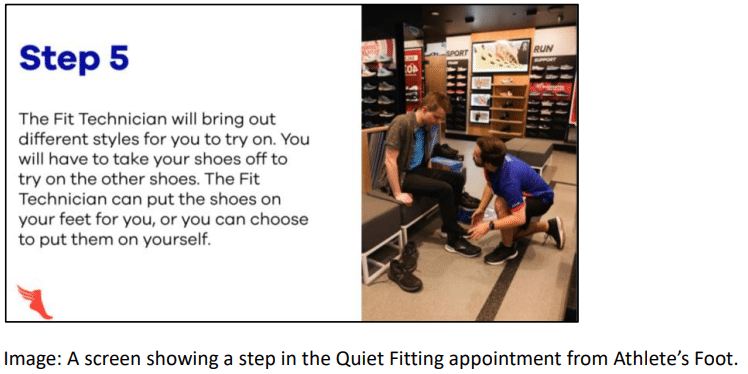One in five (1 in 5) Australians has a disability, of which 80-90% are not immediately obvious to others. Furthermore, an estimated 20% of the population identify as neurodivergent: people who have a neurology, (or brain wiring), that diverges from the neuromajority and that is characterised by differences in processing, sensing and communicating. Neurodivergent identities are diverse and include autism, dyspraxia, dyslexia, ADHD and dyscalculia. Acquired neurodivergence resulting from illness, accident and trauma, is also widely recognised under the neurodiversity umbrella. Neurodivergent people navigate barriers in everyday life, including shopping. This article is a collaboration between Inclusive Change and Aspect and is part of a series designed to showcase the innovative solutions that Australian retailers are implementing to meet the needs of ALL shoppers. The article has been informed by feedback from the lived experiences of customers representing a range of neurotypes, and market research conducted by Inclusive Change and Nature. In this article, we explore how retailers are creating accessible and inclusive shopping experiences by providing predictability and flexibility.
Common challenges in physical retail spaces
Retailers have, historically, attracted customers into their stores through the senses such as sound, lighting, and smells. Neurodivergent shoppers, many of whom have sensory systems that are extra sensitive to environmental stimuli, can find stores and shopping precincts a veritable minefield of sensory overload that may disrupt – and often halt – their shopping experience.
Common challenges in physical retail spaces include:
- spotlights directed in eyeline, glare/reflections from shiny floors or reflective materials like tabletops, complex visual patterns, halogen or fluoro lighting
- overlapping sounds like centre music, announcements, retailer music, coffee machines, beeping from checkouts, key cutting, trollies, hand dryers
- smells like incense, soap, air fresheners, food and coffee smells
- crowding, queuing, bottlenecks, stands and trolleys blocking walkways
- finding your way around, waiting or rushing
- • differences in communication methods to retail staff
- lack of understanding and judgement from retail staff and members of the public
So how can Retailers create neuroinclusive, accessible and safe spaces for all shoppers?
Preparation, planning and predictability
Inclusive Change and Nature surveyed 600 shoppers, 50% of whom identified as neurodivergent or as parents/ carers of neurodivergent people. The data highlights the statistically significant differences in neurodivergent and non[1]neurodivergent (neurotypical) shopping experiences.

Furthermore, the research highlighted that neurodivergent shoppers would choose to shop at a store that offers good wayfinding and/or sensory maps.
Sensory Maps
Sensory Maps are maps of a location that show customers where they can expect to find different sensory experiences, and the likelihood that those experiences might cause sensory overwhelm. This helps customers to pre[1]plan their journey to seek or avoid certain sensations, and to understand what strategies or sensory aids they might need in order to be comfortable when visiting the location. Sensory Maps also help customers to identify entry and exit points, and find designated Quiet Rooms, or naturally quieter areas/ spaces.

Quiet Fitting Appointments
Retailers like The Athlete’s Foot and Shoes and Sox provide flexible alternatives to general access shopping by offering Quiet Fitting appointments, where trained staff are available at off-peak times to provide extra support in a quieter environment, with fewer customers. This allows families or adults who struggle in busy, overwhelming stores to get the support they require in a calmer environment. It’s important to note that quiet fitting appointments are often accompanied by visual stories and communication boards to allow for a more inclusive communication experience.

Booking and Queueing System, Store to Boot or Online Alternatives
Retailers are increasingly providing flexible and alternative ways to visit or purchase in store. Apple stores provide a sophisticated booking and queuing system, allowing shoppers to check-in, wait somewhere nearby, receive a text message of upcoming appointment time and then make their way to the store at the time of their appointment. This helps to reduce stress and overwhelm in a busy, crowded store, and helps with predictability of wait times. Any uncertainty or unpredictability (i.e. how long will I wait?) significantly increases negative sensory experiences. Other retailers provide Store to Boot options, allowing customers to visit, but not have to wait as long, or have to carry heavy items for long distances.
What can Retailers do?
Providing tools to help plan for shopping trips in physical retail spaces, as well as visual supports in the environment (like good wayfinding, or ‘Step 1, Step 2’) goes a long way to enhancing the customer experience for all customers – but especially those shoppers who have sensory needs. Information provided via physical and digital sensory maps, or via booking systems provide customers with choice and autonomy for when and how they shop. Download the Neurodiversity In Retail report summary via www.inc-change.com.
Natalie Phillips-Mason is the Founder and Chief Ally at Inclusive Change, a pioneering change management neuroinclusion consultancy with a focus on education, consulting and research. Natalie is the member of a mixed neurotype family and works with a network of like-minded professionals to implement inclusive customer and employee experiences.

Matt Oastler works for the Aspect Autism Friendly team, who specialise in supporting retailers to develop and deliver a range of sensory accommodations, resources and quiet hours. They have developed the Autism Friendly Built Environment Design Guidelines to help designers.






















